Berlin, the capital of Germany, is currently served by a single major international airport named Berlin Brandenburg Airport (BER).
This airport became operational on 31 October 2020 and is situated near the town of Schönefeld in Brandenburg, just south of the Berlin city boundary.
It now functions as the main aviation hub for the Berlin-Brandenburg metropolitan area, consolidating air traffic that was previously accommodated by multiple airports.
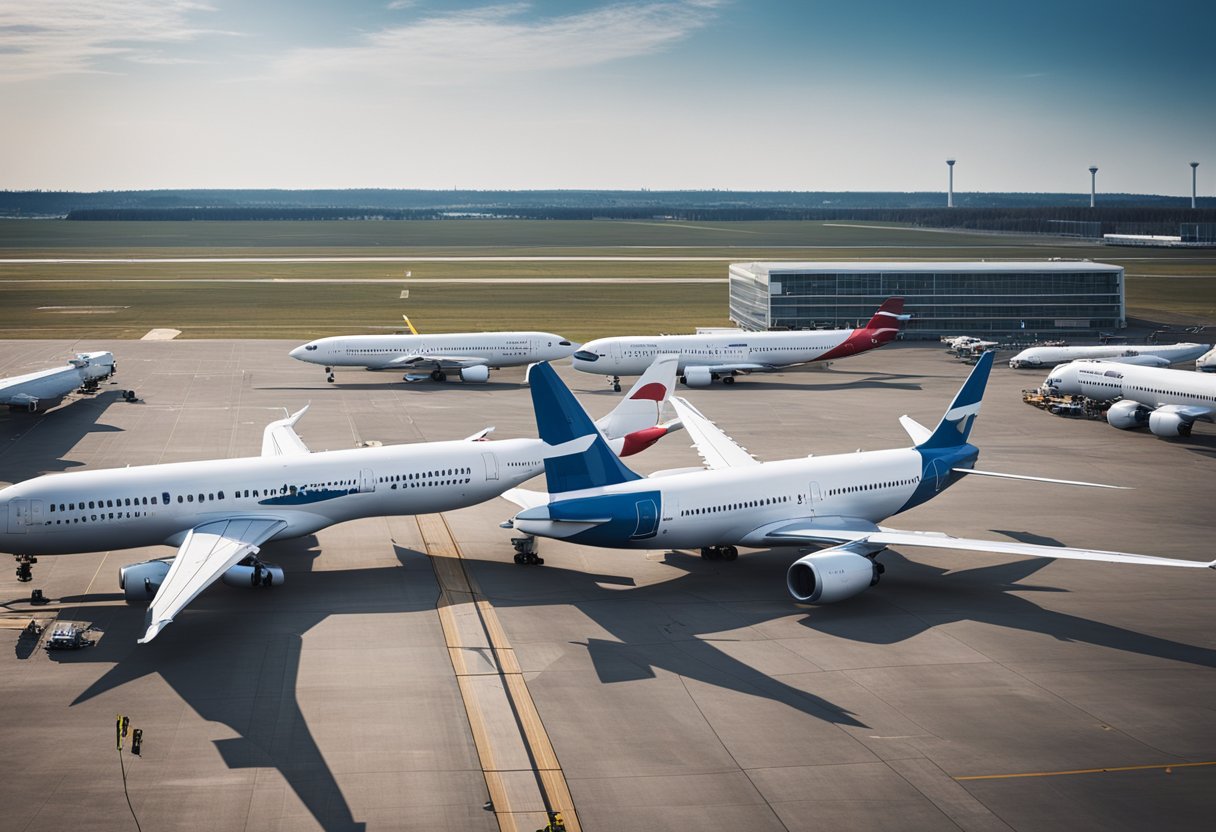
Historically, Berlin had several airports, including Tegel Airport (TXL) and Tempelhof Airport (THF), both of which have ceased operations as airports, with Tegel closing in November 2020, shortly after the opening of Brandenburg Airport.
Schönefeld Airport (SXF), which was adjacent to the current BER airport, was incorporated into the BER infrastructure and no longer operates under its former name.
Those traveling to the German capital will find that Berlin Brandenburg Airport provides comprehensive international and domestic flight services, making it the closest airport to Berlin for travelers from around the globe.
Prior to its consolidation to one major facility, the number of airports in Berlin had contributed to an intricate history of air travel for the city.
History of Airports in Berlin
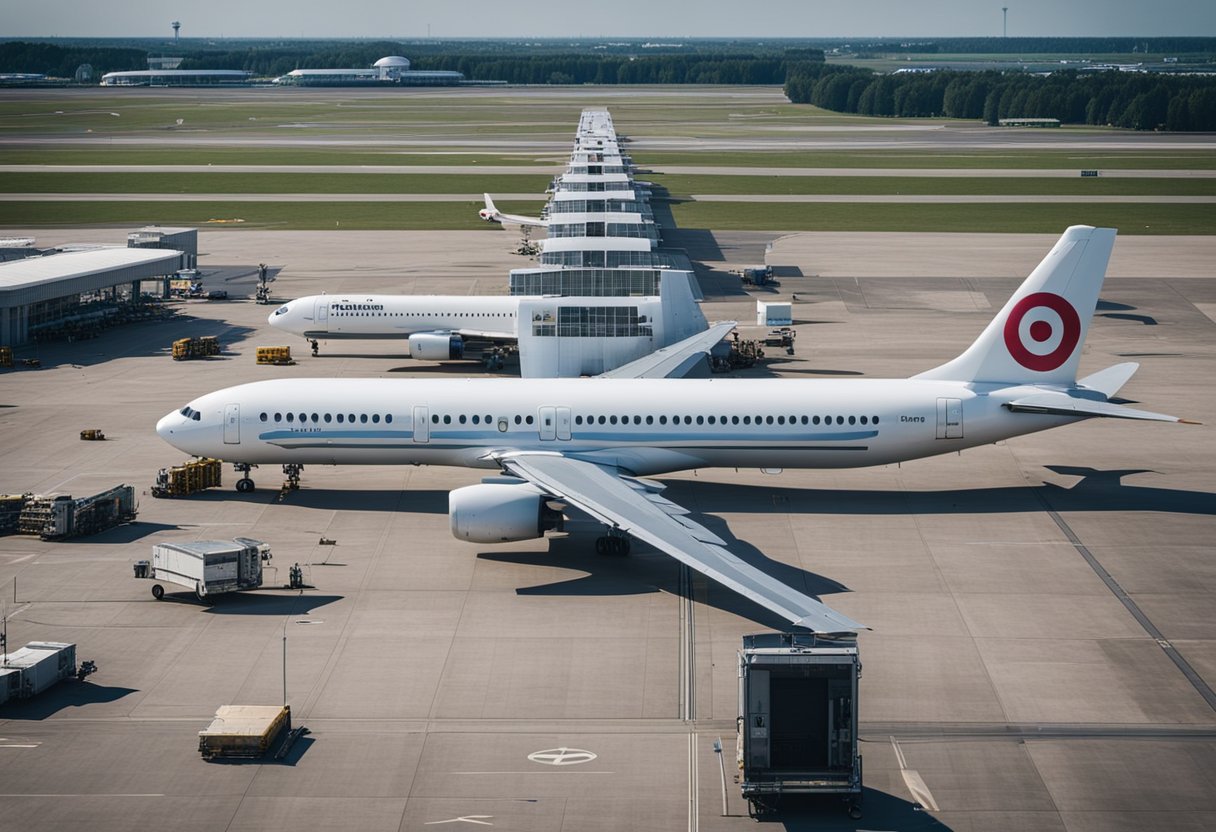
Berlin’s airport history is distinctive, reflecting the city’s changing political landscapes. This history spans from early aviation milestones to the complex role airports played during military and political crises.
Berlin Tempelhof Airport
Tempelhof, once known as the City Airport, has a rich history dating back to its inception as a simple airfield in the early 20th century.
It was significantly expanded under the Nazi government to represent the prowess of the Third Reich. Tempelhof gained global prominence during the Berlin Airlift of 1948-1949, where it served as a crucial gateway for supplying West Berlin during the Cold War blockade.
Berlin Tegel Airport
Tegel Airport, also named after Otto Lilienthal, began operations in the Cold War era and became West Berlin’s primary gateway, especially after the closure of Tempelhof in 2008. Its hexagonal terminal building was known for its short walking distances and became an iconic feature.
Tegel was praised for its efficiency and eventually closed in November 2020 following the opening of the Berlin Brandenburg Airport.
Berlin Schönefeld Airport
Operating since the DDR times, Berlin Schönefeld served as the major airport for East Berlin. Over time, it underwent numerous expansions and renovations to keep up with the growing demands of international travel.
After German reunification, Schönefeld continued to operate, handling flights primarily for low-cost and charter airlines before becoming part of the Berlin Brandenburg Airport complex.
Berlin Brandenburg Airport
The Berlin Brandenburg Airport, named after Otto Lilienthal, is the latest addition to Berlin’s aviation history. After considerable delays, the airport opened in 2020, intended to consolidate the air traffic of the Berlin metropolitan area into a single international hub.
It subsumed Schönefeld’s facilities while replacing both Tempelhof and Tegel, with the ambition to streamline Berlin’s air transport services for both domestic and international travelers.
Current Airports in Berlin
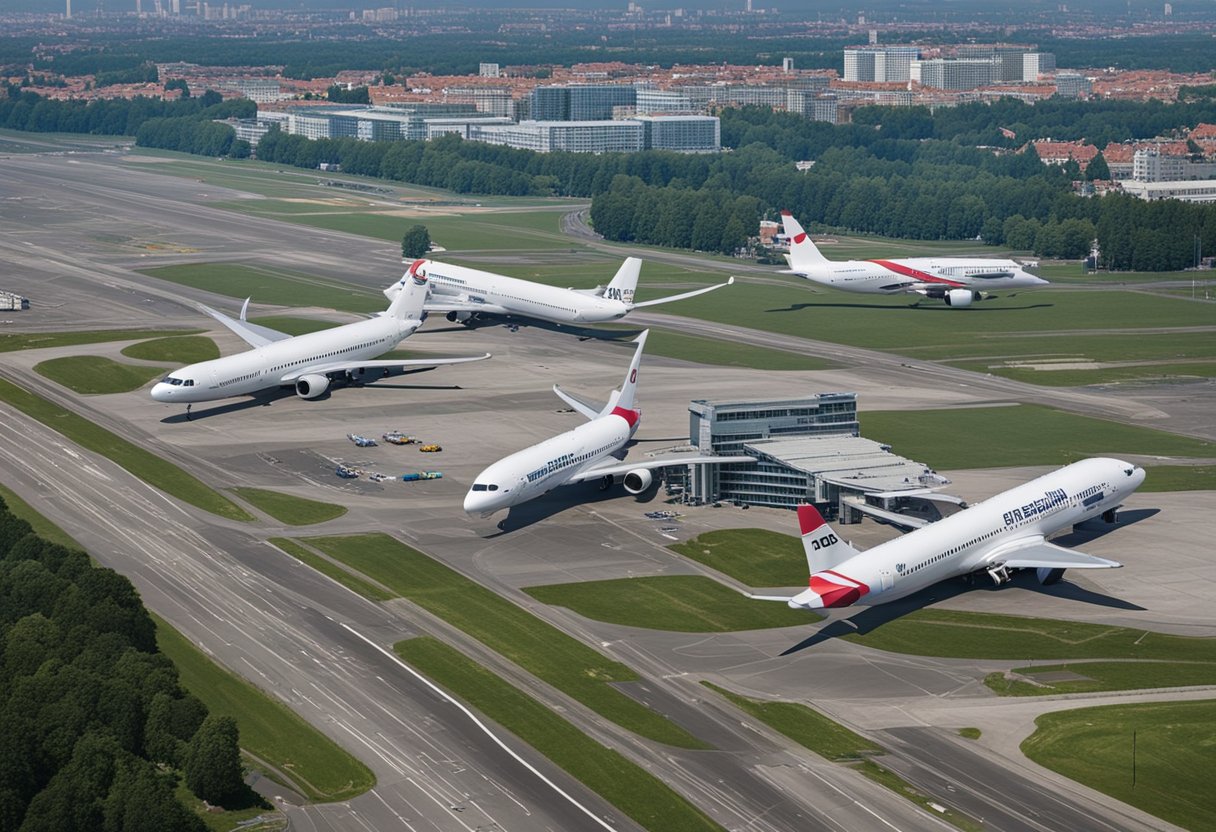
Berlin now has one major international airport that has consolidated air travel within the region, serving as the main gateway for both domestic and international flights.
Berlin Brandenburg Airport Willy Brandt
Berlin Brandenburg Airport, also known by the IATA code BER and the ICAO code EDDB, stands as Berlin’s primary international airport. It is situated just across the border of Berlin in Brandenburg, near the site of the former Schönefeld Airport.
Opened in 2020, BER represents the region’s central hub for air transportation, after a significant period involving planning challenges and construction delays. Since its opening, all commercial air traffic has been routed through this airport following the closure of Tegel and Tempelhof.
Tegel Airport Repurposing
Tegel Airport, formerly known by its IATA code TXL, was once a key airport within Berlin’s aviation infrastructure. After the opening of Berlin Brandenburg Airport, Tegel was officially closed to air traffic in November 2020.
The site is undergoing repurposing to evolve into a research and industrial park that will house technology firms and universities, thus beginning a new chapter in the history of the iconic site.
Airport Infrastructure and Facilities
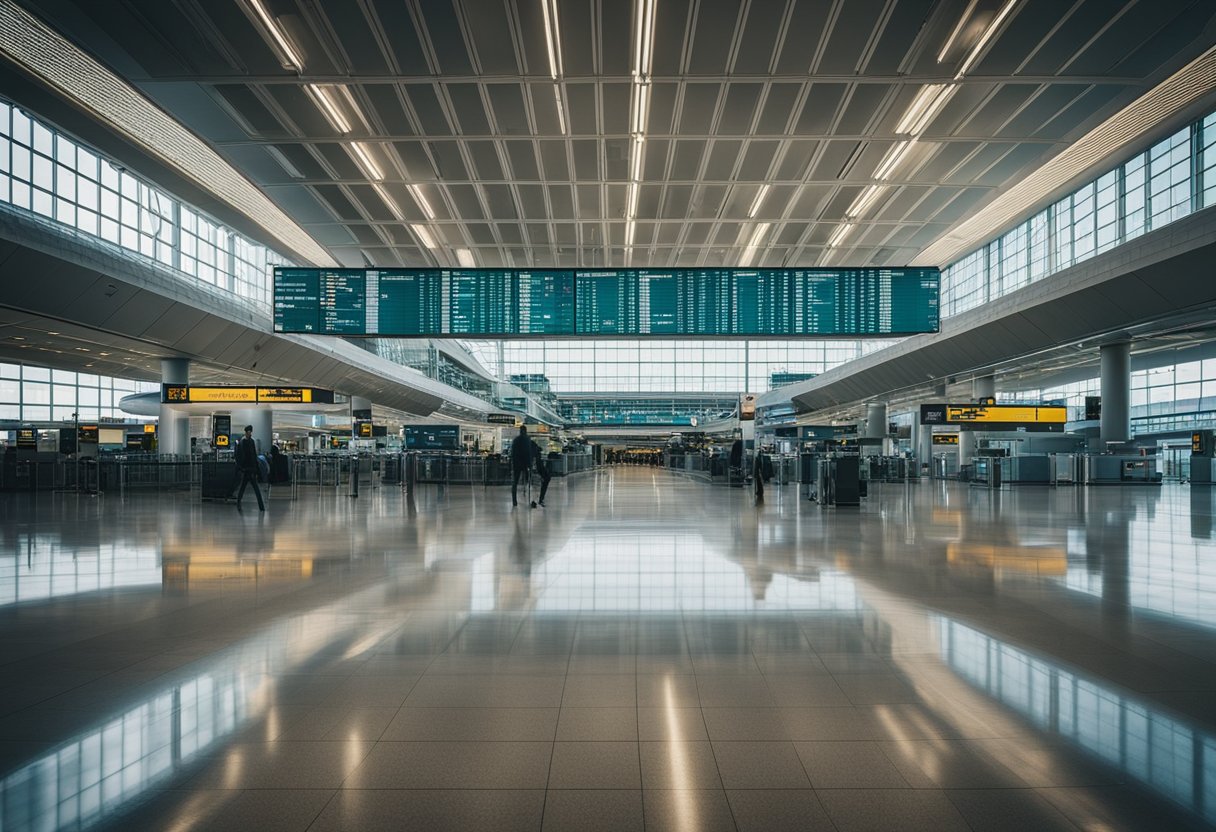
Berlin maintains a robust infrastructure with facilities designed to meet various aviation needs, ranging from passenger travel to cargo operations.
Terminals and Runways
Berlin’s aviation landscape is dominated by the Berlin Brandenburg Airport Willy Brandt (BER), which serves as the primary international gateway to the city.
BER has multiple terminals with Terminal 1 being the main hub, equipped with advanced passenger amenities and operational capabilities.
The airport features several runways that accommodate a high volume of flight operations, ensuring efficient handling of both domestic and international flights.
Ground Transportation
Ground transportation options are extensive at Berlin’s airports. Public transportation integrates seamlessly, with the railway station located beneath Terminal 1, providing fast and efficient access to and from the airport.
Passengers and visitors can avail themselves of a variety of options, including buses, taxis, and rental car services. This array of choices facilitates easy transfer between the airport and Berlin’s metropolitan areas.
Cargo and Maintenance Facilities
The cargo and maintenance facilities at Berlin’s airport are designed to support a significant throughput of goods. With dedicated cargo terminals, the logistics operations run smoothly, serving as a vital link for trade and commerce.
The maintenance facilities adhere to high standards, ensuring the safety and reliability of the aircraft fleet serving Berlin’s airport system.
Airline Presence and Flight Operations

Berlin’s aviation landscape reflects a mix of major airlines that connect the city to global destinations and a significant presence of low-cost carriers that offer economical options for travelers.
Major Airlines and Destinations
Lufthansa, Germany’s flagship carrier, maintains a steady flow of flights to and from Berlin, providing connections to numerous international and leisure destinations.
Additionally, government flights and other carriers contribute to the diverse tapestry of operations. The comprehensive list of destinations and airlines is maintained and updated on the Berlin Brandenburg Airport’s airlines and destinations page.
Low-Cost Carriers Operations
Low-cost carriers like Ryanair and EasyJet have a substantial operational base in Berlin, offering flights to a variety of destinations across Europe.
Malta Air, a subsidiary of Ryanair, alongside Eurowings, furthers the selection of low-cost options available for passengers looking to explore Europe or seeking affordable flights.
These carriers are significant contributors to the accessibility and affordability of air travel in the region.
Impact of Airports in Berlin
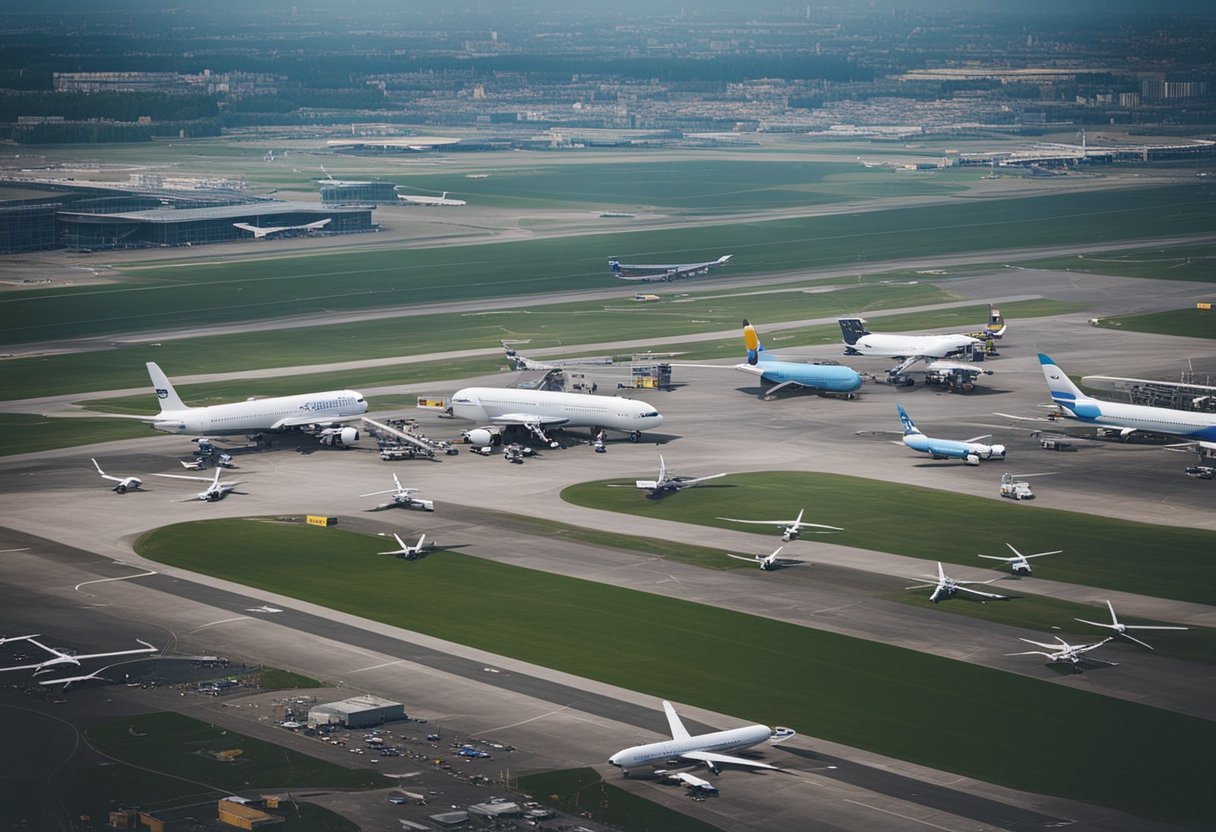
The presence of airports in Berlin has significant implications on the city’s economy, global connectivity, and environment, shaping it into a dynamic European metropolitan hub.
Economic Impact
Air transportation facilities, including Berlin Tegel Airport and Berlin Brandenburg Airport, which superseded Tegel as Berlin’s primary airport, serve as critical infrastructure propelling the local economy.
They are pivotal in promoting trade, attracting investment, and creating employment opportunities, underscoring the economic impact of airports on Berlin.
Connectivity and Tourism
Airports in Berlin, particularly Berlin Tegel Airport, historically served West Berlin and played a key role in maintaining connections during the Cold War.
The new Berlin Brandenburg Airport, now centralizes air travel, enhancing connectivity with various international destinations and bolstering the tourism industry.
This accessibility positions Berlin as a strategic city airport in Europe, supporting Berlin’s status as an attractive tourist and business destination.
Environmental Considerations
While airports are economic catalysts, they also come with environmental considerations. Airports like Berlin Schönefeld, now part of the larger Berlin Brandenburg Airport complex, have contributed to noise pollution and raised concerns over airspace usage.
Conscious of these impacts, airport authorities in Berlin are tasked with implementing measures to mitigate environmental footprint, ensuring a balance between air travel advantages and sustainable development.
Transportation to and from the Airports
Berlin, the capital of Germany, is served by several airports, but currently, the major one in operation is Berlin Brandenburg Airport (BER). Travelers can avail themselves of various modes of ground transportation to reach or depart from this hub, including car and taxi services as well as extensive public transport options.
Car and Taxi Services
Travelers can access car rental services at BER, which offer the flexibility to travel at one’s own pace. Taxi ranks are also conveniently located just outside the terminals. The drive to central Berlin from BER takes approximately 30-45 minutes, depending on traffic conditions.
- Car Rentals: Available at airport terminals.
- Taxi Services: Fixed prices to specific zones in Berlin.
Public Transport Options
Berlin Brandenburg Airport (BER)
- Airport Express (FEX) and regional trains connect BER to Berlin Central Station several times an hour.
- S-Bahn: The S9 and S45 lines run every 20 minutes between the airport and the city center.
- Express Bus Services: Operate between BER and various locations in Berlin.
Former Airports
- Berlin Tegel (TXL) and Berlin Schönefeld (SXF) were previously the city’s main airports and had similar public transport connections, including bus, Express Bus, and S-Bahn services. These airports are currently not in operation following the opening of BER.
Future Developments in Airport Infrastructure
The evolution of airport infrastructure in Berlin is primarily focused on the Berlin Brandenburg International Airport (BER), the region’s major international gateway.
Following the commencement of BER in 2020 and the subsequent closure of Berlin Tegel Airport, which previously served as one of Berlin’s primary airports, all eyes have shifted to the future plans and enhancements of BER.
The development plans involve the expansion of BER to increase its capacity and to streamline the overall passenger experience. Primarily, the focus will be on enhancing the existing terminals and constructing new ones if needed.
Attention is directed at the former Schoenefeld Airport, designated as Terminal 5 of BER, assessing its function within the broader airport infrastructure.
In anticipation of future demand, BER’s operators are considering the progressive development of airport facilities to ensure it can handle the expected increase in air traffic. This may include the erection of new structures and the upgrade of the old terminal facilities to meet the latest standards of efficiency and comfort.
Despite the challenges faced during its construction, Brandenburg Airport is poised to transform further, fulfilling its role as Berlin’s sole international air travel hub. Details about current projects and specific timelines are, however, subject to construction schedules and operational requirements.
Frequently Asked Questions
Berlin, Germany’s bustling capital, is served by several airports, facilitating both domestic and international travel. This section provides answers to common questions about the city’s air travel infrastructure.
What are the names of the airports currently operating in Berlin?
Berlin is currently served by Berlin Brandenburg Airport (BER), which is the primary airport for both international and domestic flights.
How many international airports can be found in Berlin?
There is one main international airport operational in Berlin: Berlin Brandenburg Airport (BER).
From which airports in Berlin can I fly internationally?
International flights are primarily conducted through Berlin Brandenburg Airport (BER), which is the main hub for international air travel in the city.
What is the main airport used for flights in and out of Berlin?
Berlin Brandenburg Airport (BER) is the central airport used for all flights entering and departing from Berlin.
What facilities do Berlin’s airports offer for travelers?
Berlin’s airports offer a range of facilities including check-in services, security checkpoints, baggage handling, and amenities for shopping and dining.
How do I get from Berlin’s primary airport to the city center?
From Berlin Brandenburg Airport (BER), travelers have multiple options to reach the city center, including trains, buses, taxis, and car rental services.